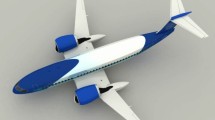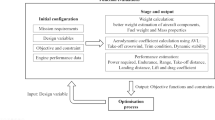Abstract
A new strategy for solving multidisciplinary design optimization problems is presented in this paper. The main idea of this approach is based on the use of designer experiences and attention to his/her preferences during design optimization which is implemented using a concept called the fuzzy preference function. Two important advantages of this approach are: (1) using the experiences of expert people during optimization and (2) transforming a constrained multiobjective design optimization problem into an unconstrained single-objective design optimization problem. The multidisciplinary design optimization of an unmanned aerial vehicle (UAV) is considered to show the performance of the proposed methodology. The optimization problem in this case study is a constrained two-objective problem (minimization of takeoff weight and drag of the cruise phase), and the genetic algorithm (GA) is utilized as the optimizer. Performance, weight, aerodynamics, center of gravity, trim and dynamic stability are the considered modules in the multidisciplinary analysis that are modeled using empirical and semiempirical equations. The optimization results show that the proposed strategy has been able to offer an optimal design where has higher performance relative to other methods from the point of view of objective functions, low computational cost and simplicity of implementation.

























Similar content being viewed by others
References
Alam MI, Pant RS (2018) Multi-objective multidisciplinary design analysis and optimization of high altitude airships. Aerosp Sci Technol 78:248–259
Allison DL, Morris CC, Schetz JA, Kapania RK, Watson LT, Deaton JD (2015) Development of a multidisciplinary design optimization framework for an efficient supersonic air vehicle. Adv Aircr Spacecr Sci 2:17–44
Anderson J (1976) Aircraft performance and design. McGraw-Hill Companies, New York
Azizi MA, Malaek SMB, Ashrafizadeh M, Taheri SM (2013) Aircraft design cycle time reduction using artificial intelligence. Aerosp Sci Technol 26:244–258
Babaei AR, Setayandeh MR (2015) Constrained optimization of a commercial aircraft wing using non-dominated sorting genetic algorithm. Int J Adv Des Manuf Technol 8:51–61
Balling RJ, Wilkinson CA (1997) Execution of multidisciplinary design optimization approach on common test problems. AIAA J 35:178–186
Carmer EJ, Dennis JE, Frank PD, Lewis RM, Shubin GR (1994) Problem formulation for multidisciplinary optimization. SIAM J Optim 4:754–776
Cavus N (2009) Multidisciplinary and multi-objective design optimization of an unmanned combat aerial vehicle. Ph.D. Thesis, Middle East technical university
Daskilewicz MJ, German BJ, Takahashi TT, Donovan S, Shajanian A (2011) Effects of disciplinary uncertainty on multi-objective optimization in aircraft conceptual design. Struct Multidiscip Optim 44:831–846
Deb K (2002) A fast and elitist multi-objective genetic algorithm: NSGA-II. IEEE Trans Evol Comput 6:182–197
Du S, Wang L (2016) Aircraft design optimization with uncertainty based on fuzzy clustering analysis. J Aerosp Eng 29:1–9
Fazeley HR, Taei H, Naseh H, Mirshams M (2016) A multi-objective, multidisciplinary design optimization methodology for the conceptual design of a spacecraft bi-propellant propulsion system. Struct Multidiscip Optim 53:145–160
Haupt RL, Haupt SE (2004) Practical genetic algorithms. Wiley, Chichester
Henderson R (2009) Multidisciplinary design optimization of airframe and engine for emission reduction. Ms.C. Thesis, University of Toronto
Huang H, Gu Y, Du X (2006) An interactive fuzzy multi-objective optimization method for engineering design. Eng Appl Artif Intell 19:451–460
Kartalopoulos SV (1996) Understanding neural networks and fuzzy logic basic concepts and applications. IEEE Press, New York
Lee KS, Geem ZW (2005) A new meta-heuristic algorithm for continuous engineering optimization: harmony search theory and practice. Comput Methods Appl Mech Eng 194:3902–3933
Marler RT, Arora JS (2004) Survey of multi-objective optimization methods for engineering. Struct Multidiscip Optim 26:369–395
Martins JRRA, Lambe AB (2013) Multidisciplinary design optimization: a survey of architectures. AIAA J 51:2049–2075
Mastroddi F, Gemma S (2013) Analysis of pareto frontiers for multidisciplinary design optimization of aircraft. Aerosp Sci Technol 28:40–55
Mirshams M, Naseh H, Taei H, Fazeley HR (2014) Liquid propellant engine conceptual design by using a fuzzy-multi-objective genetic algorithm (MOGA) optimization method. Proc IME G J Aerosp Eng 228:2587–2603
Ng TTH, Leng GSB (2002) Application of genetic algorithms to conceptual design of a micro-air vehicle. Eng Appl Artif Intell 15:439–445
Nguyen NV, Choi SM, Kim WS, Lee JW, Kim S, Neufeld D (2013) Multidisciplinary unmanned combat air vehicle system design using multi-fidelity model. Aerosp Sci Technol 26:200–210
Roshanian J, Ebrahimi M (2013) Latin hypercube sampling applied to reliability-based multidisciplinary design optimization of a launch vehicle. Aerosp Sci Technol 28:297–304
Roshanian J, Bataleblu AA, Farghadani MH, Ebrahimi B (2017) Metamodel-based multidisciplinary design optimization of a general aviation aircraft. In: 12th World congress on structural and multidisciplinary optimization 05-09, Braunschweig, Germany
Roskam J (1987) Airplane design: part six, 1st edn. Roskam Aviation and Engineering Corporation, Lawrence
Roskam J (2001) Airplane flight dynamics and automatic flight controls. DAR Corporation, Lawrence
Ross TJ (2004) Fuzzy logic with engineering applications. Wiley, Chichester
Sadraey MH (2013) Aircraft design: a systems engineering approach, 1st edn. Wiley, New York
Sepulveda E, Smith H, Sziroczak D (2019) Multidisciplinary analysis of subsonic stealth unmanned combat aerial vehicles. CEAS Aeronaut J 10:431–442
Tedford NP, Martins JRRA (2010) Benchmarking multidisciplinary design optimization algorithms. Optim Eng 11:159–183
Tianyuan H, Xiongqing Y (2009) Aerodynamic/stealthy/structural multidisciplinary design optimization of unmanned combat air vehicle. Chin J Aeronaut 22:380–386
Tyan M, Nguyen NV, Kim S, Lee JW (2017) Database adaptive fuzzy membership function generation for possibility-based aircraft design optimization. J Aircr 54:1–11
Wang LX (1997) A course in fuzzy systems and control. Prentice hall international Inc, Upper Saddle River
Yao W, Chen X, Ouyang Q, Tooren MV (2012) A surrogate based multistage-multilevel optimization procedure for multidisciplinary design optimization. Struct Multidiscip Optim 45:559–574
Author information
Authors and Affiliations
Corresponding author
Ethics declarations
Conflict of interest
The authors declare that they have no conflict of interest. This work was carried out by me as part of my Ph.D. thesis in the Mechanical Engineering Department of Malek Ashtar University of technology.
Ethical approval
This manuscript does not contain any studies with human participants or animals performed by any of the authors.
Additional information
Communicated by V. Loia.
Publisher's Note
Springer Nature remains neutral with regard to jurisdictional claims in published maps and institutional affiliations.
Rights and permissions
About this article
Cite this article
Setayandeh, M.R., Babaei, AR. Multidisciplinary design optimization of an aircraft by using knowledge-based systems. Soft Comput 24, 12429–12448 (2020). https://doi.org/10.1007/s00500-020-04684-3
Published:
Issue Date:
DOI: https://doi.org/10.1007/s00500-020-04684-3




